Geochemical constraints on CO 2-rich mantle source for the Kocebu Seamount, Magellan Seamount chain in the western Pacifi c*
LIU Yuhao , ZHANG Guoliang , ZHANG Ji , WANG Shuai
1 Center of Deep Sea Research & Key Laboratory of Marine Geology and Environment, Institute of Oceanology, Chinese Academy of Sciences, Qingdao 266071, China
2 Laboratory for Marine Geology, Qingdao National Laboratory for Marine Science and Technology, Qingdao 266000, China
3 University of Chinese Academy of Sciences, Beijing 100049, China
4 Center for Ocean Mega-Science, Chinese Academy of Sciences, Qingdao 266071, China
A bstract The alkaline oceanic island basalts (OIBs) with under-saturated SiO 2 and high contents of CaO and alkaline are usually attributed to mantle sources different from typical tholeiitic OIBs. Based on the results of high pressure and temperature experiment study, the genesis of silica under-saturated alkaline basaltic melts could be explained by the role of CO 2, thus, the genetic relationship of alkaline basalts with CO 2 has become a topic of relevance because it is closely related to the deep carbon cycle. The Magellan Seamount chain in the West Pacifi c Seamount Province has wide distribution of alkali basalts. For the fi rst time, we collected alkaline basalt samples from the Kocebu Seamount of the Magellan Seamount chain and found that magmatic apatites widely occur in the less evolved volcanic rock samples, and the high contents of phosphorus should be a feature of the alkaline OIBs of the Magellan Seamounts. Compared with typical OIBs, these alkaline volcanic rocks have higher CaO and P 2 O 5, lower SiO 2 content, negative anomaly of high fi eld strength elements (HFSEs), more distinctly negative anomaly of potassium (K) and the ubiquity of titanaugite, indicating a CO 2-rich mantle source. Based on the relatively high K 2 O and TiO 2 contents and La/Yb ratio and low MgO content of these alkaline rocks, we suggest that the volcanic rocks of the Magellan Seamounts are originated from carbonated eclogites derived possibly from ancient subducted altered oceanic crust.
Key word: alkaline oceanic island basalts (OIBs); carbonatite; geochemistry; mantle source; Magellan Seamounts
1 INTRODUCTION
Ocean island basalts (OIBs) are usually geochemically enriched with relatively higher concentration of incompatible trace elements than mid-ocean ridge basalts (MORBs). The OIBs are generally considered to have resulted from partial melting of a mantle source that has been affected by recycled materials, i.e., recycled oceanic crust through ancient plate subduction (Hofmann et al., 1986; Weaver, 1991). The partial melting of recycled oceanic crust usually produces melts with saturated silica (Hirose and Kushiro, 1993; Kawamoto and Holloway, 1997). However, the alkaline OIBs usually have under-saturated SiO2and enriched alkaline content, which cannot be produced by partial melting of dry mantle peridotites (Hirose and Kushiro, 1993), but could be produced by partial melting of carbonated peridotites (Hirose, 1997; Dasgupta et al., 2007a) or carbonated eclogites (Dasgupta et al., 2006; Hammouda et al., 2009; Kiseeva et al., 2012). It has been shown by previous studies that the mantle melting with CO2can reduce the content of SiO2in the melt (Dasgupta et al., 2007b), which suggest that CO2probably acts as a controlling factor for the generation of alkali basalt. Moreover, mantle xenoliths collected from the alkali basalts usually show obvious “carbonatitic fi ngerprints” (Coltorti et al., 1999; Kogarko et al., 2001; Neumann et al., 2002). Hence, study of the geochemistry of alkali basalts has important implications on both the genesis of OIBs and the deep carbon cycle.
The West Pacifi c Seamount Province is underlain by the oldest oceanic crust of the Pacifi c (Müller et al., 2008), and has the densest seamount distribution in the Pacifi c (Li, 2010). The alkali basalts are widely distributed in the West Pacifi c Seamount Province (Zhu, 2002; Wei et al., 2017a). However, the genesis of these alkali basalts and their mantle source remain debated. Therefore, study on the geochemistry of the alkali OIBs would help understand how the West Pacifi c Seamount Province was formed. The Magellan Seamounts Trail, as a part of the West Pacifi c Seamount Province, was widely known as an area of oceanic mineral resources (e.g., Co-crusts and rare earth elements-rich phosphorites) (Pan et al., 2002; Wei et al., 2017b). The previous studies in this area generally focused on the Co-crusts (Pan and Liu, 1999; Wang et al., 1999; Zhu et al., 2001; Sun et al., 2006; Bu et al., 2007; Ye et al., 2008; Song et al., 2009; Ren et al., 2011; Wang et al., 2016) or phosphorites (Pan et al., 2002; Wei et al., 2017b), thus, the distribution of mineral resources and their genesis have been extensively studied. The previous studies have investigated the seamount topography based on the fractal methods (Zhang et al., 2009) and traced the origin of the seamounts trail based on geophysics methods (Zhao et al., 2010).
To understand petrology and petrogeochemistry, Smith et al. (1989) and Koppers et al. (1998, 2003) studied six seamounts from the Magellan Seamounts Trail based on mineral40Ar/39Ar ages and Sr and Pb isotopes, and ascribed their genesis as the result of activities of deep mantle-rooted South Pacifi c Isotopic and Thermal Anomaly (SOPITA). However, Tang et al. (2019) found that, at the western part of Magellan Seamounts, some alkali basalts have magma sources ranging from EMI to EMII, probably suggesting that the Magellan Seamounts have more than one mantle source. Moreover, Zhu (2002), and Wei (2017a) collected bedrock samples from Ita Mai Tai, Gelenddzhink, Govorov, Il’ichev and Pallada seamounts, and the relevant geochemistry data were reported. However, previous studies mostly focused on regional tectonic genesis and evolution of the seamounts (Koppers et al., 1998, 2003; Tang et al., 2019), rock composition and mineral composition (Zhu, 2002; Wei et al., 2017a), hence the genesis of alkali basalts still remains unclear. The unique characteristics of the alkali basalts (for example, high P2O5content) of the Magellan Seamounts Trail have been interpreted by most previous studies as result of secondary minerals by alteration (e.g., Zhu, 2002; Wei et al., 2017a) without a detailed study of the chemical composition and genesis of the primary rock-forming minerals. Thus, it is necessary to constrain the genesis of alkali basalts of Magellan Seamounts based on detailed study of whole-rock geochemistry and mineral chemistry. In this study, we provide new whole-rock geochemistry data and the electronic microprobe analysis (EPMA) data of mineral chemical composition from the Kocebu Seamount of this seamount chain, which has not been previously sampled. The objectives are to examine the genesis of the alkali basalts of the Magellan Seamounts Trail and their possible relationship with CO2in the deep mantle source.
2 GEOLOGICAL SETTING AND SAMPLE
The Magellan Seamounts Trail is located to the east of the Mariana Trench and the west of Pigafetta Basin. It has a number of seamounts distributed along the trend from northwest to southeast with a length of about 1 200 km. The basement rocks of this area include pillow basalts, Jurassic tholeiites and Cretaceous alkali basalts (Liang and Zhu, 2002). The ages of the seamounts range mostly 120–80 Ma and generally decrease from northwest to southeast (Koppers et al., 2003). Twenty samples were obtained from the Kocebu Seamount, where igneous rock samples have never been collected previously. Some of the samples in this study are covered with Fe-Mn crusts. Most samples are moderately altered, while porphyritic structure can be observed in the slightly altered samples.
The phenocrysts are dominated by clinopyroxene and plagioclase in this study, while fresh olivine phenocryst has not been observed. Clinopyroxenes and plagioclases are mostly euhedral crystals. Apatites and ilmenites can be observed as auxiliary minerals in most samples. Apatites have two types of crystal, anhedral apatites mostly spread at the edge of the plagioclases or fi lling the cells among whole rocks, euhedral apatites mostly are granular or needle crystals. Ilmenites mostly are granular crystals.
3 METHOD
Major elements and some trace elements (Cr, V, etc.) were analyzed on fused glass discs with PANalytical AXIOS Minerals instrument at the Rock-Mineral Preparation and Analysis Lab, the Institute of Geology and Geophysics (IGG; Beijing), Chinese Academy of Sciences (CAS). Samples were analyzed on fused glass discs with an Axios sequential X-ray Fluorescence Spectrometer, and glass discs were produced at 1 000°C using a lithium tetraborate flux (Li2B4O7) in a mixture consisting of 0.5 g of sample and 5 g of lithium tetraborate. The loss on ignition (LOI) of sample powders was determined at a temperature of 1 000°C. The measurements were monitored using standards BCR-2 and BHVO-2. The accuracy of the analytical results was controlled by measuring standard reference material BCR-2 and BHVO-2 (Supplementary Table S1).
Trace elements analyses were determined using an inductively coupled plasma mass spectrometry (ICPMS) at the Second Institute of Oceanography, Ministry of Nature Resources (MNR). For trace element analyses, 50 mg of sample powder was precisely weighed and transferred into Teflon capsule; sample powder was moisturized by 0.1-mL Mili-Q water; 1.5-mL HF, 1.5-mL HNO3and 0.1-mL HClO4were added in turn; the Teflon capsule was sealed in stainless steel bomb jacket; and lastly the unit was heated in oven at 190°C for 48 h. When the units cooled down, the Teflon capsules were taken out; opened and heated on a hotplate at 120°C to evaporate the dissolutions to dryness; 1.5-mL HClO4was added, and heated on a hotplate at 120°C until the white smoke was totally dispersed; 3-mL HNO3was added, and heated on a hotplate at 120°C to evaporate the dissolutions to dryness. After that, 3-mL 1∶1 HNO3was added, sealed in stainless steel bomb jacket, and heated in oven at 190°C for 24 h to re-dissolve the residues. Finally, the solutions were diluted by 2 000 times using Mili-Q water and analyzed by ICP-MS using Rh and Re as internal standards. The standard solutions were diluted to 1, 5, 10, 20, 50, and 80 μg/L to produce the calibration curve with linear regression coefficients all above 0.999. To evaluate the accuracy, BHVO-2 and BCR-2 were run as external standards, and the results are shown in Supplementary Table S2.
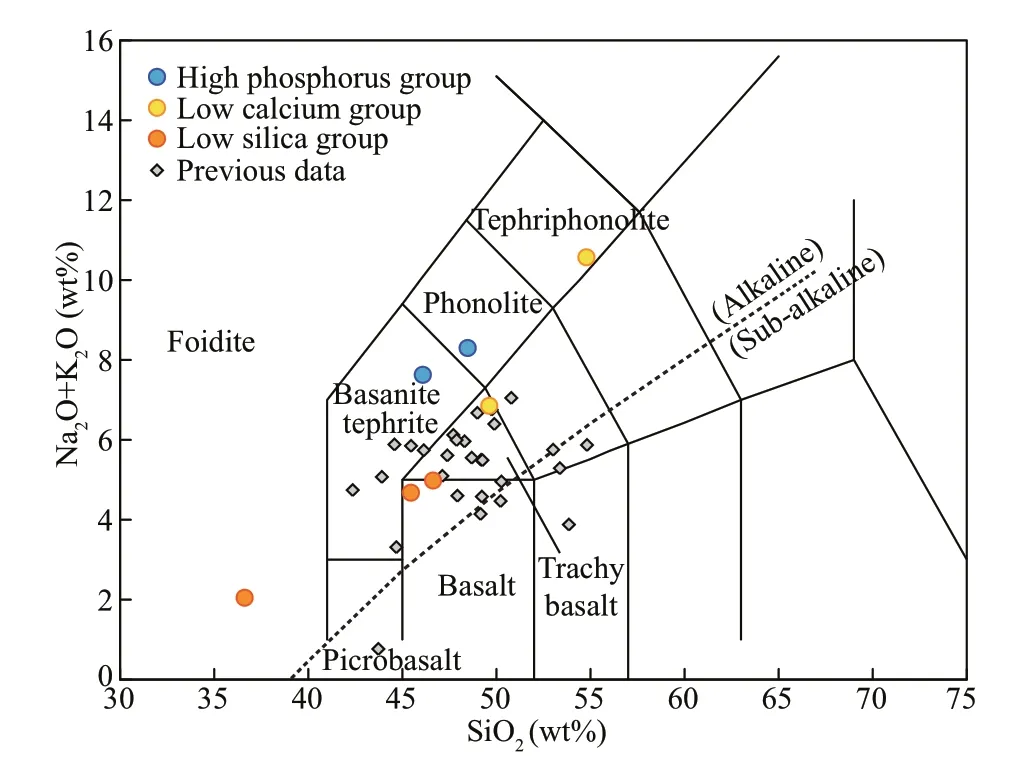
Fig.1 Total Alkali Silica (TAS) diagram (after Le Maitre, 1984)
The in-situ microanalysis was conducted at the Institute of Oceanology, Chinese Academy of Sciences (CAS) on a JXA-8230 EPMA. The analyses were performed under conditions of accelerating voltage of 20 kV and sample current of 10 nA for clinopyroxene and feldspar, accelerating voltage of 15 kV and sample current of 10 nA for apatite. The data were calibrated by using an oxide-ZAF correction program.
4 RESULT
4.1 Major elements
The results of major elements are shown in Table 1. According to the nomenclature of Le Maitre (1984), the igneous rocks of Magellan Seamounts are trachy basalt, basanite tephrite, tephriphonolite and foidite, and all igneous rocks are alkaline rock (Fig.1). Compared with typical OIBs, e.g., Hawaii OIBs, the igneous rocks of the Magellan Seamounts have obviously lower SiO2contents, lower MgO and higher CaO, TiO2, and P2O5contents. These results are similar to those of the experimentally determined carbonated eclogite-derived melt (except for P2O5) and the nephelinites of Canary Islands (Fig.2), where carbonatites extruded (Hoernle et al., 2002) and the mantle xenoliths show metasomatism by carbonated melts (Neumann et al., 2002). These igneous rock samples can be divided into three groups, high phosphorus group, low calcium group, and low silica group, based on their SiO2, CaO, and P2O5contents (Fig.2). Samples of high phosphorus group have obviously higher P2O5contents (4.2–4.7 wt%) and relatively higher CaO contents (9.8–10 wt%) than those of the other groups, and have SiO2contents of between 44.5–46.9 wt% (Fig.2). The samples of low calcium group have lower CaO content (1.6%–2.2%), higher SiO2(47.2–54.6 wt%) and lower P2O5(0.89–0.92 wt%) contents than other groups. Samples of low silica group have lower SiO2content (36.9%–46.9%), higher CaO (8.9–11.8 wt%) and P2O5(1.4–2.0 wt%) contents than the other groups (Fig.2).
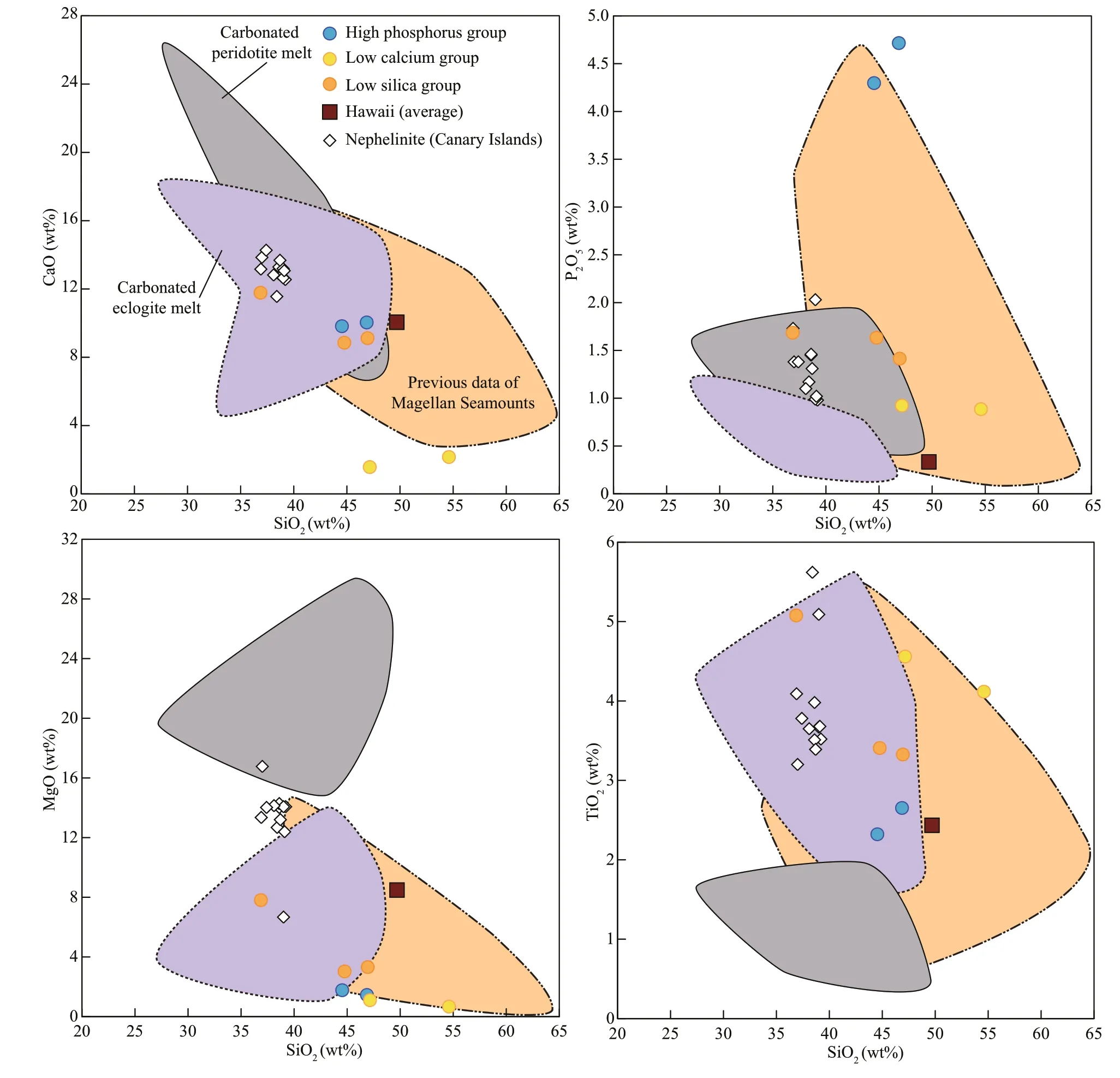
Fig.2 Major elements-SiO 2 diagram of Magellan Seamounts Trail
4.2 Trace elements
The results of trace elements are shown in Table 2. To avoid the effect of seafloor alteration, we eliminated samples that have obvious Ce anomalies. All samples of the Magellan Seamounts have OIB-type rare earth elements (REEs) pattern, but the different groups have variable trace elements patterns (Fig.3). Compared with typical OIBs, the high phosphorus group has slight Nb and Ta negative anomalies and P
obvious positive anomaly (Fig.3). High phosphorus group has higher La/Nb and La/Yb ratio than OIBs, even higher than the primitive mantle (PM) (Fig.4b & c). The low calcium group has an obvious K positive anomaly (Fig.3). The low calcium group has higher La/Nb ratio, similar to the PM, but La/Yb ratio higher than PM, similar to the OIBs (Fig.4b & c). Compared with typical OIBs, the low silica group samples have slight Zr and Hf negative anomalies, and K has negative anomaly (Fig.3). For the relations between major and trace elements, there are obvious correlations between not only P2O5and La, but also P2O5and La/Nb ratio (Fig.4a & b). The low silica group has similar La/Nb ratio with nephelinites of Canary Islands, and the highest P2O5sample of low silica group has higher La/Nb ratio than OIBs, even higher than PM (Fig.4b). Samples of the low silica group have higher La/Yb ratio than typical OIBs, especially for the samples with low SiO2or high P2O5contents of this group (Fig.4c).
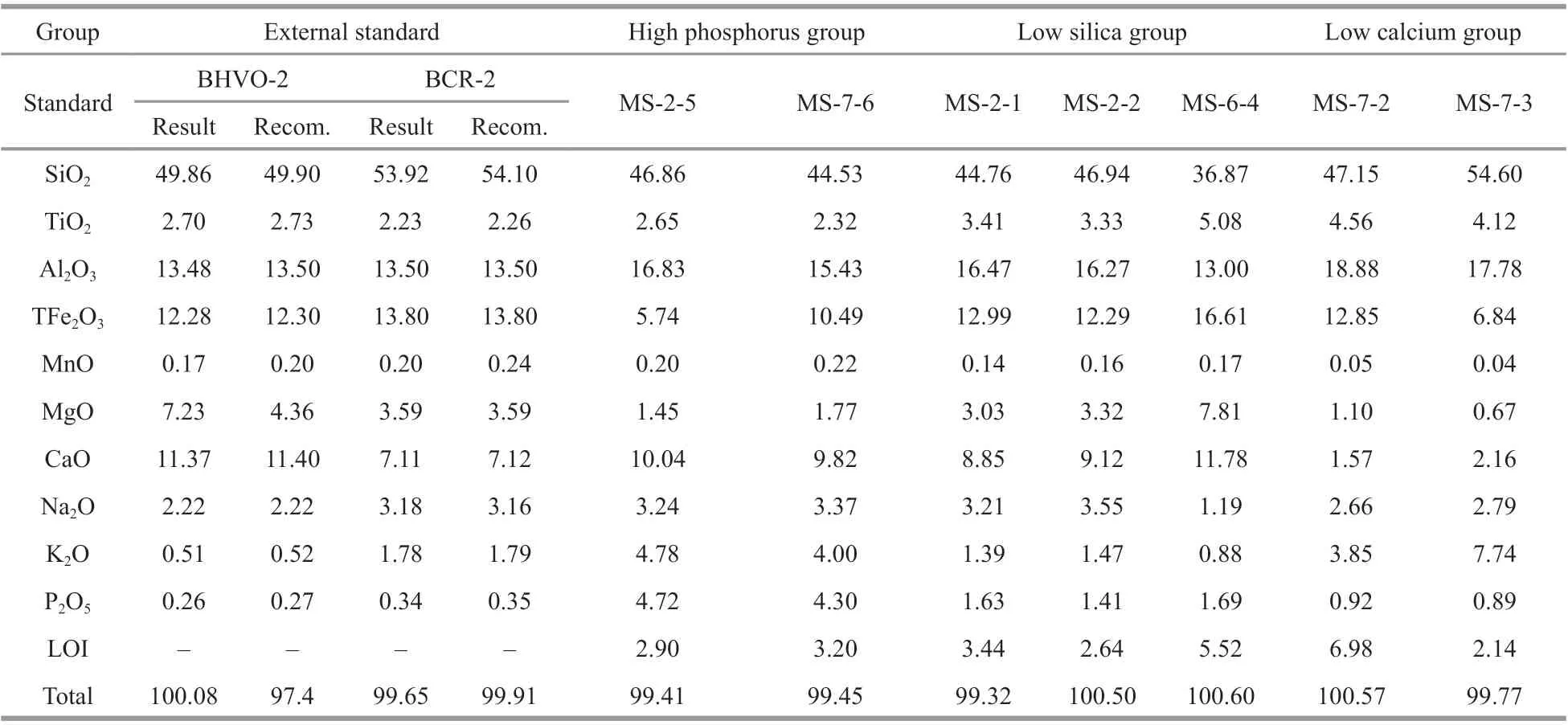
Table 1 Results of major elements oxides (wt%) of Magellan Seamounts
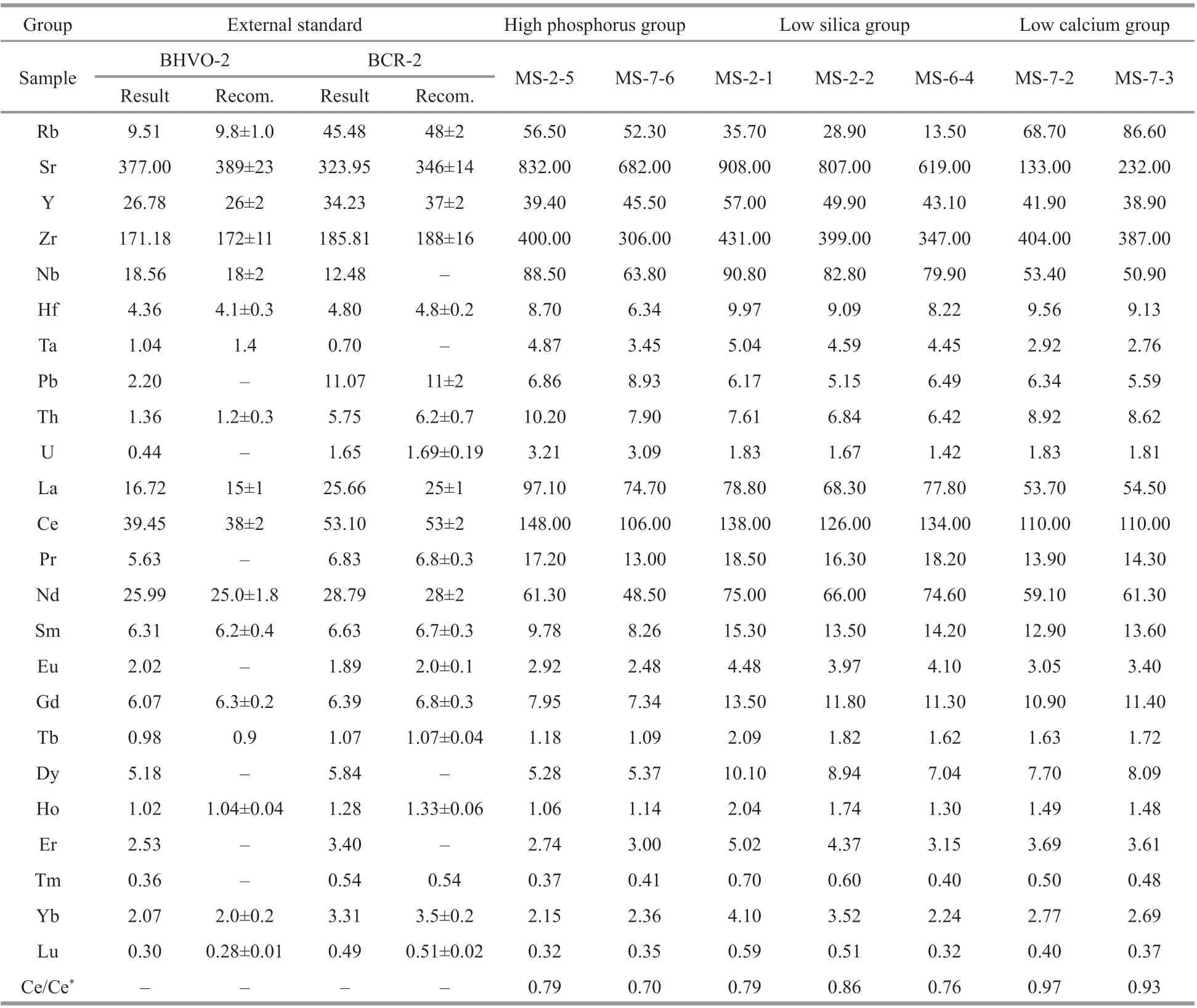
Table 2 Results of trace elements concentrations (×10 -6) of Magellan Seamounts
4.3 Petrography and mineral chemistry
The results of in-situ microanalysis on apatites, clinopyroxenes and feldspars are shown in Supplementary Tables S2–S4, respectively, and Supplementary Table S1 shows the range, average and number of analyzed. High phosphorus group has two samples: MS-2-5 and MS-7-6 (Fig.5a: MS-2-5, b: MS-7-6). The main minerals are potassium feldspars, plagioclases, apatites and ilmenite. Apatites mostly are anhedral crystal. Plagioclases enclosed within by potassium feldspars, and the An# plagioclases are mostly between 50 to 70, the highest value is 75, and the average is 64. Low silica group has fi ve samples: MS-2-1, MS-2-2 andMS-6-4 (Fig.5c: MS-6-4, d: MS-2-1). The main minerals are clinopyroxenes, plagioclases, apatites and ilmenite, wherein MS-6-4 does not contain plagioclases. Mineral compositions between samples in this group are different, with the decrease of SiO2and CaO content (from Fig.5c to 5d), clinopyroxenes are decreasing, plagioclases was increasing, and crystal forms of apatites vary from euhedral crystal to anhedral crystal. The An# plagioclases are mostly between 60 to 70, with the highest value of 76 and the average value of 68. Low calcium group has two samples: MS-7-2 and MS-7-3 (Fig.5e: MS-7-2, b: MS-7-3). The main minerals are potassium feldspars, plagioclases, apatites, and ilmenite. Apatites mostly are euhedral crystal. Plagioclases were wrapped by potassium feldspars, and the An# of plagioclases are mostly between 10 to 50, with the highest value of 57, and the average value of 29.
5 DISCUSSION
5.1 Origin of phosphorus: original or secondary phosphate?
Previous studies suggest that phosphorites are widely distributed along the Magellan Seamounts Trail (Pan et al., 2002; Zhu, 2002; Wei et al., 2017a). The enrichment phosphorus in igneous rocks has usually been described as the effects of secondary phosphate as indicated by the obvious Ce anomaly (Zhu et al., 2001; Zhu, 2002; Wei et al., 2017a). However, as shown in Fig.3, the samples without Ce anomalies from the Magellan Seamounts Trail in this study have higher P2O5contents than typical OIBs. Here we analyzed the chemical compositions of apatites by EPMA to decipher the origin of phosphorus enrichment. We found two types of apatites in these samples: allotriomorphic apatites (Fig.5a & b) that mostly exist in the samples of high phosphorus group, and idiomorphic apatites (Fig.5c, e, & f) that mostly exist in low silica group and low calcium group. It is shown in Fig.6 that the P2O5contents and CaO/P2O5ratio are different among different types of apatites. Idiomorphic apatites show relatively high P2O5content (30–42 wt%) and low CaO/P2O5ratio (ca. 1.3). Allotriomorphic apatites show relatively low P2O5content (24–32 wt%) and CaO/P2O5ratios higher than 1.6.
In marine environment, natural crystallized or metasomatic apatites are all francolites (Ye et al., 1989). Due to the replacement between CO32ˉ and PO42ˉ, the CaO/P2O5ratio of francolites could be higher than 1.32 (calculated as fluorapatite: Ca5(PO4)3F). Previous experimental study suggested that, in marine environment, secondary phosphates probably mixed with calcite (Ye et al., 1989), which would enhance the CaO/P2O5ratio. Hence, the allotriomorphic apatites from the high phosphorus group probably are secondary phosphate, the higher P2O5content than other groups probably are the effect of secondary phosphate. The idiomorphic apatites with CaO/P2O5ratios similar to fluorapatite suggest that these idiomorphic apatites are original magmatic minerals. Even in the samples with the lowest P2O5content, the content of phosphorus is obviously higher than typical OIBs (Fig.2). Therefore, the obviously higher phosphorus of these samples could be features of magmas that formed alkaline rocks in this study area.
5.2 Effect of seafloor alteration
The composition of rocks collected from the ocean would be more or less affected by seawater alteration. It is necessary to discuss the changes of whole rock chemistry caused by alteration. For the seawater alteration, previous studies have been carried out in detail. Hart (1973) believes that for major elements, the content of K2O will increase signifi cantly, the content of MgO, SiO2, CaO, and MnO would decrease slightly, while the content of Na2O, Al2O3, and TiO2would remain unchanged. For trace elements, Ba, Rb, Sr, V, Zr, Cs, and U would increase, Co and Cr would decrease, while Cu, Ga, Sc, and Zn would remain basically unchanged. Staudigel et al. (1981) reported that seawater alteration will not affect Fe2O3(T) and TiO2, but the content of K2O, Rb, and Cs will increase; the content of REEs will decrease, but their patterns will not generally change. Zhang and Smith-Duque (2014) showed that seawater alteration would not affect the TiO2content, but it may cause a small decrease in CaO, MgO, and Na2O content and a signifi cant increase in K2O content. In terms of trace elements, seawater alteration will cause the increase of Rb, Cs, Ba, and U content, and decrease of Th content. It has little influence on REEs and high fi eld strength elements (HFSEs) (e.g., Nb, Hf). Summarizing the previous research results, the main result of seawater alteration is increase of K2O content, increase or decrease of large ion lithophile elements (LILEs) (for example, Rb, Ba), without signifi cant influences on HSFEs and REEs.
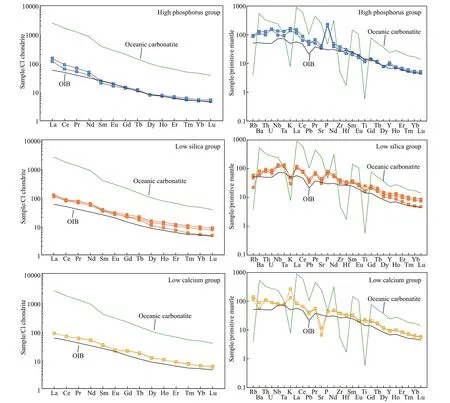
Fig.3 REE and trace elements patterns of three groups
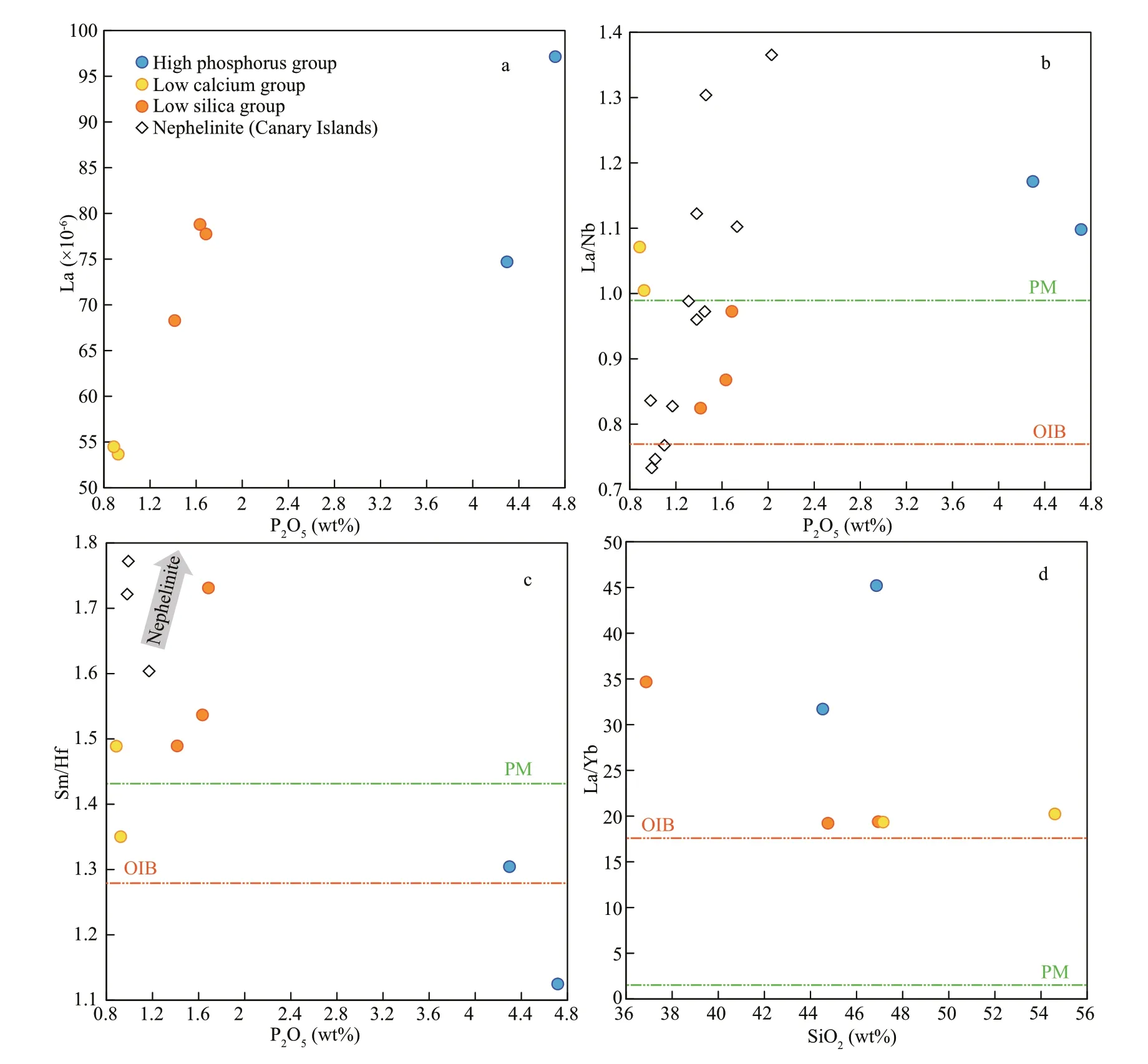
Fig.4 La-P 2 O 5, La/Nb-P 2 O 5, Sm/Hf-P 2 O 5, and La/Yb-SiO 2 diagram
For rocks in Magellan Seamounts, phosphatization also widely exists. The effects of phosphatization on the composition of whole rocks have also been studied in detail. Pan et al. (2007), collected a large number of seamount phosphates in the Western Pacifi c, and found that most of these phosphates are accessory minerals that appear in needle, interlayers, or veins. The average of CaO/P2O5ratio was 1.60. Ren and Wei (2007) studied REEs in phosphates, and found that oceanic phosphates will inherit the characteristics of REEs in seawater, which are mainly manifested by obvious negative Ce anomalies and higher Y/Ho ratios. The distribution characteristics are common in Pacifi c seamount phosphates (Pan et al., 2002). Summarizing previous research results, secondary phosphates in the Pacifi c Ocean are mainly characterized by high CaO/P2O5, Y/Ho ratio and obvious negative Ce anomalies.
For this study, results of the EPMA analysis suggest that the secondary phosphate exists in some samples, indicating that some of the samples in this study were affected by phosphate. The high Y/Ho ratio may have multiple origins (e.g., magma generated by partial melting of the CO2and halogen rich source may also have a high Y/Ho ratio (Zhang et al., 2017)), in order to exclude the effect of secondary phosphate, we chose Ce/Ce*(CeN2/(LaN×PrN)) as an indicator to measure the effect of the sample after the phosphate, and exclude samples with Ce/Ce*<0.70 to eliminate the effect of phosphatization (Supplementary Table S2). For seawater alteration, we select elements that are insensitive to seawater alteration (such as HFSEs and REEs) as the indicators of discussion in order to exclude the effect of seawater alteration.
5.3 Effect of magma fractional crystallization
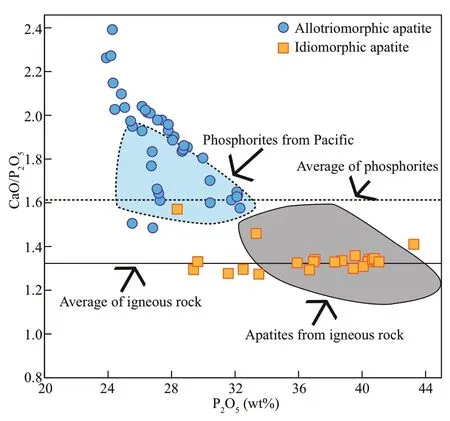
Fig.6 Apatites CaO/P 2 O 5-P 2 O 5 diagram
Based on major element compositions, the low silica group samples have highly variable bulk rock SiO2contents, and their SiO2contents show correlations with other elements (e.g., Ca, P). Their clinopyroxene CaO contents also decrease with increasing bulk rock SiO2(Fig.7, bulk rock SiO2increases from 36.87 wt% for MS-6-4 to 44.76 wt% for MS-2-1), similar to the bulk rock data, suggesting that the bulk rock CaO decreased as clinopyroxene crystallization proceeded. Thus, the samples of the low silica group have undergone fractional crystallization of clinopyroxenes and apatites.
Some elements, especially light rare earth elements (LREEs) and middle rare earth elements (MREEs), are strongly enriched in apatite (Chazot et al., 1996), hence crystallization of apatite probably causes the positive anomalies of Nb, Ta, Zr, and Hf (e.g., Zhang et al., 2017). In this study, LREEs (for example, La) and La/Nb, Sm/Hf ratios have negative correlations with P2O5, probably suggests the control of apatite on REEs (Fig.4a, b, c). Moreover, the sample with the highest P2O5content has higher La/Nb and Sm/Hf ratios than typical OIBs, similar to or even higher than PM (Fig.4b, c). These features probably show that the samples of this study have obviously higher initial La/Nb and Sm/Hf ratios than typical OIBs, suggesting that the primary magmas probably have negative anomalies of Nb and Hf. The samples of low CaO and high SiO2from the low silica group probably evolved from high CaO and low SiO2magmas. Thus, the low silica group is the most suitable group for discussing the mantle source.
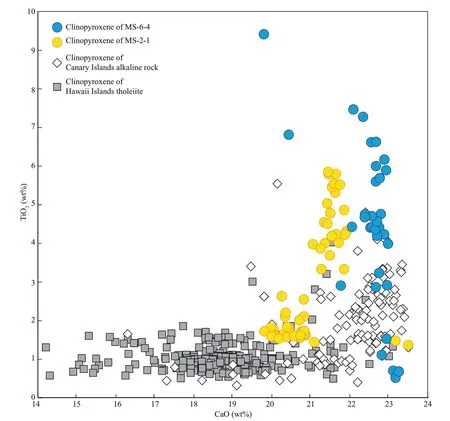
Fig.7 Clinopyroxenes CaO-TiO 2 diagram
5.4 Mantle source
Compared with typical OIBs, the samples from the low silica group have obviously higher CaO and lower SiO2contents that are similar to the nephelinites of Canary Islands (Fig.2). The low silica group samples have obviously higher P2O5contents than typical OIBs, similar to the nephelinite that has the highest P2O5content (Fig.2). Previous studies suggested that the high P2O5content and the appearance of apatite are usually the features of Siunder-saturated rocks that were formed from carbonated silicate melt (Green and Wallace, 1988; Hauri et al., 1993; Zhang et al., 2017). The negative anomalies of HFSEs (e.g., Nb, Ta, Zr, Hf) (Figs.3, 4b & c) and K (Fig.3) are obviously different from the lavas from typical mantle peridotites, but similar to those of the oceanic carbonatites (Fig.3).
Clinopyroxene, as the early stage magmatic minerals of carbonated silicate melts, probably bears important information on mantle source, because it tends to crystallize from high Ca magmas, such as carbonated melts (Beccaluva et al., 1992; Ivanikov et al., 1998; Lee and Wyllie, 1998). The compositions of clinopyroxene crystalized from different magmatic systems are different. Figure 7 shows the compositional difference of clinopyroxene crystallized from different magmatic systems. Compared with typical OIBs (e.g., Hawaiian OIBs), the clinopyroxenes of this study have higher CaO and TiO2contents, similar to the OIBs of the Canary Island, where carbonatites were found. The partition coefficients of Ti in clinopyroxene in equilibrium with carbonate melts is generally higher than those in equilibrium with silicate melts (Rudnick et al., 1993; Klemme et al., 1995), thus, the existence of high-Ti clinopyroxene in these samples suggest that they were derived from a carbonated primary magma.
Carbonated peridotites and carbonated eclogites are usually considered as the mantle sources of carbonated silicate melts (Hirose, 1997; Dasgupta et al., 2007a; Hammouda et al., 2009; Gerbode and Dasgupta, 2010; Kiseeva et al., 2012). For this study, the anomalously high TiO2and the relatively low MgO contents are obviously different from the primary carbonated peridotite melts (Fig.2), but similar to the carbonated eclogite melts. The very high La/Yb ratio (Fig.4d) probably suggests the effects of a high proportion of residual garnet in the source mantle. Hence, we suggest that carbonated eclogites, probably derived from subduction-related oceanic crust, are the mantle source of carbonated silicate melts that contributed to the alkaline volcanic rocks of the Kocebu Seamount.
6 CONCLUSION
The volcanic rocks of Magellan Seamounts are alkaline and have higher CaO, P2O5and lower SiO2contents than typical OIBs. Igneous rocks of Magellan Seamounts can be divided into three groups, and the samples that have low CaO and high SiO2contents probably are evolved rocks. Primary minerals of samples are clinopyroxenes, feldspars, apatites, and ilmenites. The existence of primary magmatic apatites suggests the high phosphorus contents for alkaline primary magmas of the Magellan Seamounts. Clinopyroxenes in this study mostly are titanaugites, whose contents of CaO and TiO2are higher than the clinopyroxenes from typical tholeiites, similar to clinopyroxenes from carbonatites. The obviously higher CaO and P2O5, lower SiO2contents than typical OIBs, and HFSE negative anomalies and widespread titanaugites and apatites probably suggested a carbonated mantle source. The relatively higher TiO2, lower MgO contents and relatively higher La/Yb ratio suggest that the volcanic rocks of Magellan Seamounts might have carbonated eclogite in the source mantle.
7 DATA AVAILABILITY STATEMENT
All data generated and/or analyzed during this study are available from the corresponding author upon reasonable request.
8 ACKNOWLEDGMENT
We are thankful to the crew and scientists involved with the Magellan Seamounts cruise. We appreciate the help of XUE Dingshuai and LIU Yanhong of Institute of Geology and Geophysics, the Chinese Academy of Sciences, for the major elements analysis. We appreciate the help of ZHU Jihao of Second Institute of Oceanography, Ministry of Nature Resources, for the trace elements analysis. Thanks to the two reviewers for their valuable suggestions.
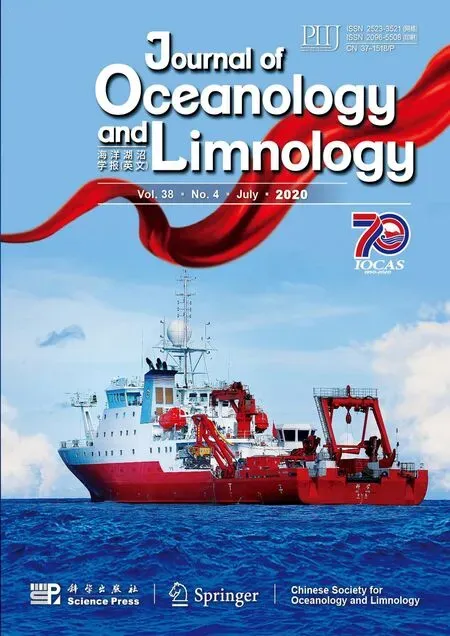 Journal of Oceanology and Limnology2020年4期
Journal of Oceanology and Limnology2020年4期
- Journal of Oceanology and Limnology的其它文章
- Review on observational studies of western tropical Pacifi c Ocean circulation and climate*
- Research progress of TiO 2 photocathodic protection to metals in marine environment*
- Smart anticorrosion coating based on stimuli-responsive micro/nanocontainer: a review*
- Status of genetic studies and breeding of Saccharina japonica in China*
- To be the best in marine sciences*
- A review of progress in coupled ocean-atmosphere model developments for ENSO studies in China*
